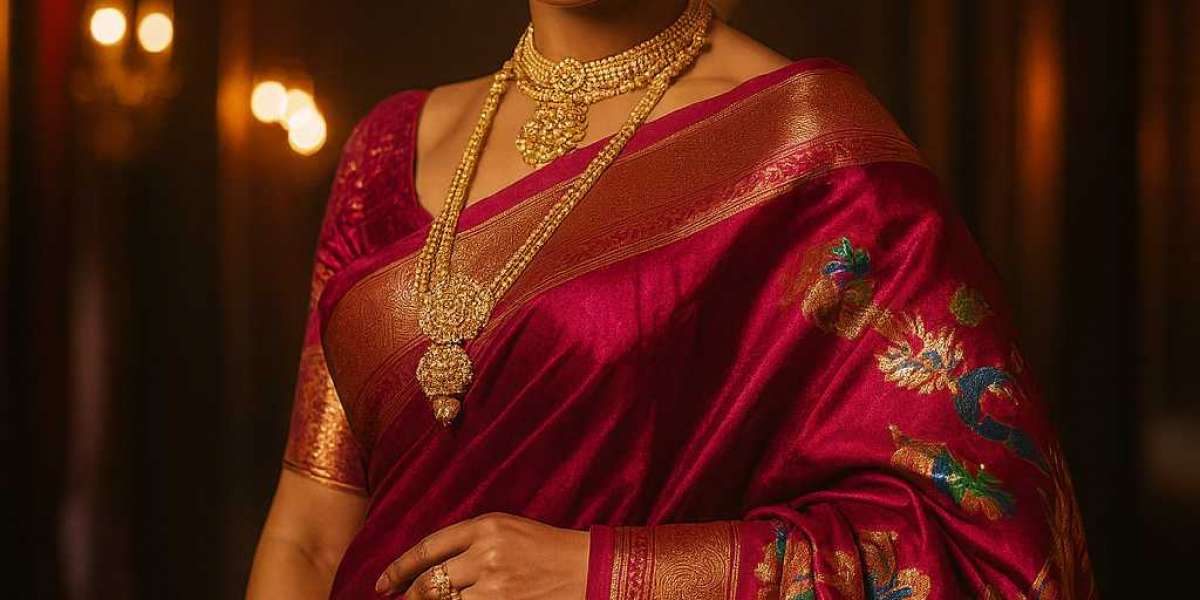When we think of timeless Indian fashion, one name stands out with royal grace — the Paithani Saree. Born in the ancient town of Paithan in Maharashtra, this magnificent weave has transcended centuries, cultures, and continents. From adorning Marathi brides in temple courtyards to gracing international fashion ramps, the Paithani’s journey mirrors India’s evolving identity — deeply traditional yet ever-adaptive.
Let’s take a storytelling walk through time to trace how the Traditional Paithani Saree became an icon not only in Maharashtra but also across the globe.
The Royal Beginning: Threads from the Deccan (2nd Century BCE – 10th Century CE)
The story of the Paithani Saree begins over 2,000 years ago in the small town of Paithan, near Aurangabad. Back then, it was not just a saree but a symbol of luxury and dignity. The Satavahana kings encouraged the art of weaving gold and silk threads together, and the Paithani became known as “the fabric of pure gold.”
It was woven with real zari made from gold and silver threads, and every piece was hand-dyed using natural colors extracted from flowers, leaves, and minerals. Even in ancient times, these sarees were traded to Rome and Persia — early signs of its global appeal.
The Era of the Queens (11th – 18th Century)
During the Yadava and Peshwa dynasties, the Maharashtrian Paithani Saree found its place in royal wardrobes. Every queen had her collection of Paithanis, often custom-made with motifs symbolizing power and prosperity — peacocks, lotuses, parrots, and vines.
Weavers from Yeola, a town near Nashik, became famous for their craftsmanship. Even today, the Yeola Paithani Saree stands as the gold standard of authenticity. Its shimmering zari borders and handwoven pallu can take months, sometimes years, to create. Each saree tells a story of devotion, patience, and art.
During this time, Paithani became an heirloom — passed from one generation to another. It wasn’t just clothing; it was heritage woven in silk.
The British Era and the Silent Struggle (19th – 20th Century)
With industrialization, handlooms began to fade under the shadow of machine-made fabrics. The weavers of Paithan and Yeola struggled to preserve their craft. Cheaper textiles from England flooded the Indian market, and Paithani weaving nearly disappeared.
But in the heart of Maharashtra, traditional families and local patrons kept the flame alive. They continued weaving the Traditional Paithani Saree for weddings, rituals, and festivals. Slowly, it began to represent resistance — a quiet celebration of Indian craftsmanship against colonial industrial dominance.
The Revival of Glory (Late 20th Century)
By the late 1900s, India’s renewed pride in its cultural heritage led to a revival of handlooms. Designers and fashion historians rediscovered the Paithani Saree, realizing it wasn’t just a cultural artifact — it was wearable art.
The Golden Paithani Saree, in particular, became a symbol of luxury at Marathi weddings. Brides wore it as a mark of status and grace, with the glimmering zari reflecting the sacred fire of the wedding rituals.
In Yeola, dedicated weavers brought innovation while preserving tradition — introducing lighter silk, brighter hues, and more intricate pallus without losing the original weave. The Yeola Paithani Saree became the crown jewel of Maharashtra’s textile identity.
Paithani Meets the World: 21st Century Fashion Evolution
Fast forward to today — the Paithani Saree is no longer confined to Marathi households. Its luminous weave has caught the eye of designers across India and beyond. Fashion shows in London, Paris, and New York have showcased reinterpretations of Paithani — from lehengas and gowns with Paithani borders to fusion jackets with zari motifs.
International stylists see it as “India’s answer to brocade,” while Indian designers proudly call it “the queen of silks.” Whether draped traditionally at a Maharashtrian wedding or reimagined as a modern cape on the runway, the Paithani carries the same grace and grandeur it did centuries ago.
One of the key brands championing this legacy today is House of Hind, a leading destination for authentic and designer Paithanis. From handcrafted Maharashtrian Paithani Sarees to premium Golden Paithani Sarees, House of Hind blends heritage with modern aesthetics, allowing women from New York to Nagpur to experience timeless Indian artistry.
Paithani and the Modern Indian Woman
For the modern woman, the Traditional Paithani Saree is more than a cultural outfit — it’s a statement. It speaks of strength, elegance, and pride. Brides today choose Paithani not only for its beauty but for its symbolism — representing their connection to roots even as they embrace the world.
Whether it’s a bride walking into a temple in Pune or a model walking down a New York runway, the Paithani reflects the same philosophy: tradition never goes out of style.
Colors, Motifs, and Meaning: The Art Behind the Weave
Every color and motif in a Paithani has meaning. Red and green signify prosperity and fertility, while golden zari represents purity. The peacock design symbolizes beauty and grace, while the lotus signifies spirituality.
This deep symbolism makes every Yeola Paithani Saree a personal story, unique to the wearer. The precision of handloom weaving ensures no two sarees are ever alike — each piece remains a one-of-a-kind creation.
Global Appeal, Indian Soul
Today, the Paithani has reached fashion capitals around the world. Bollywood stars, global influencers, and fashion icons are proudly wearing it. Yet, what makes it truly special is that its essence remains unchanged. Despite crossing oceans and cultures, it remains rooted in its Marathi soul.
The fusion of old and new — heritage and innovation — is exactly what keeps the Paithani relevant. It’s a living art form that bridges generations, telling India’s story through silk and gold.
Conclusion: A Weave Beyond Time
From the looms of Paithan to the lights of New York, the Paithani Saree continues its majestic journey — untouched by time, yet always in tune with the moment. It’s not just a garment; it’s an emotion woven with history, craftsmanship, and pride.
As the world looks for fashion that feels authentic, sustainable, and soulful, the Paithani stands tall — not just as a fabric, but as a story of India’s eternal elegance.
For those who wish to own this legacy, House of Hind offers exquisite collections of Yeola Paithani Sarees, Maharashtrian Paithani Sarees, and Golden Paithani Sarees — each piece a tribute to the centuries-old artistry that continues to define Indian luxury across the world.














